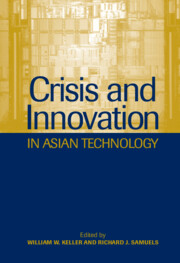Book contents
- Frontmatter
- Contents
- Figures and Tables
- Contributors
- Acknowledgments
- 1 Innovation and the Asian Economies
- 2 Japanese Production Networks in Asia: Extending the Status Quo
- 3 Crisis and Innovation in Japan: A New Future through Technoentrepreneurship?
- 4 Crisis, Reform, and National Innovation in South Korea
- 5 From National Champions to Global Partners: Crisis, Globalization, and the Korean Auto Industry
- 6 Crisis and Adaptation in Taiwan and South Korea: The Political Economy of Semiconductors
- 7 China in Search of a Workable Model: Technology Development in the New Millennium
- 8 Economic Crisis and Technological Trajectories: Hard Disk Drive Production in Southeast Asia
- 9 Continuity and Change in Asian Innovation
- Index
4 - Crisis, Reform, and National Innovation in South Korea
Published online by Cambridge University Press: 15 December 2009
- Frontmatter
- Contents
- Figures and Tables
- Contributors
- Acknowledgments
- 1 Innovation and the Asian Economies
- 2 Japanese Production Networks in Asia: Extending the Status Quo
- 3 Crisis and Innovation in Japan: A New Future through Technoentrepreneurship?
- 4 Crisis, Reform, and National Innovation in South Korea
- 5 From National Champions to Global Partners: Crisis, Globalization, and the Korean Auto Industry
- 6 Crisis and Adaptation in Taiwan and South Korea: The Political Economy of Semiconductors
- 7 China in Search of a Workable Model: Technology Development in the New Millennium
- 8 Economic Crisis and Technological Trajectories: Hard Disk Drive Production in Southeast Asia
- 9 Continuity and Change in Asian Innovation
- Index
Summary
The greatest strengths in South Korea's national innovation system in earlier decades became its most serious liabilities in the 1990s, as South Korea failed to adapt to the rapidly changing political and economic environment. This chapter first assesses the impact of the Asian economic crisis of 1997 on South Korea's national innovation system. The crisis resulted in numerous negative consequences in the short term but also provided a rare opportunity for long-term reform. The chapter then discusses how South Korea has progressed in reengineering the various aspects of the technonational innovation system that has bearing on the future competitiveness of its economy. South Korea will make major changes to accommodate to multinationalization, but increasing globalism will be a means toward a nationalist end.
Beyond Technonationalism
South Korea's phenomenal economic growth in the 1960s and the 1970s, during the first two decades of its industrialization, may be attributed to its strong system for national innovation. But major strengths in the early decades have become liabilities in more recent times, as South Korea failed to adjust to rapidly changing political and economic circumstances. This failure, together with mismanagement of the financial sector and foreign investor panic, led to the onset of a major economic crisis in 1997.
- Type
- Chapter
- Information
- Crisis and Innovation in Asian Technology , pp. 86 - 107Publisher: Cambridge University PressPrint publication year: 2003
- 3
- Cited by



